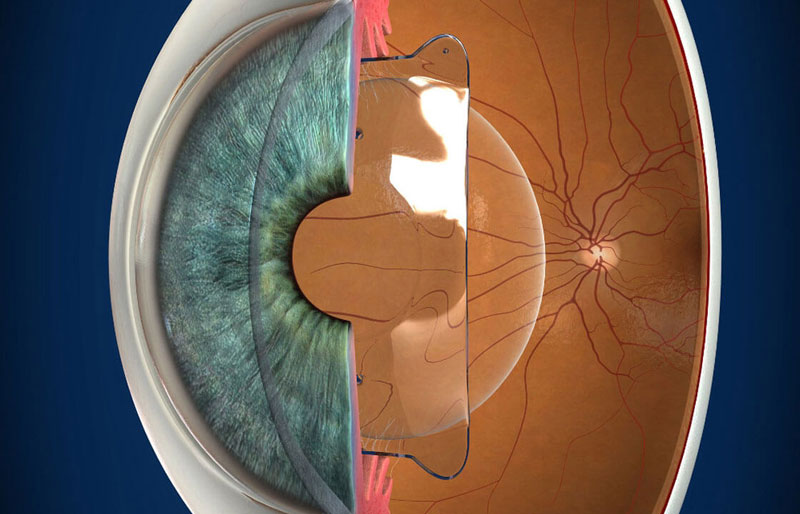
What is ICL?
Implantable collamer lens or ICL, called by its manufacturer Visian ICL, is a soft, flexible gel-lens used in refractive surgeries for the permanent correction of myopia (nearsightedness), made of a collagen copolymer material Collamer®, named by combining "collagen" and "polymer".

Collamer does not cause a reaction inside the eye and it contains an ultraviolet blocker that provides protection to the eye. The ICL procedure is a popular alternative to LASIK and PRK since it requires no removal of the corneal tissue. The most widely used posterior chamber pIOL is the Visian ICL V4, an implantable collamer lens manufactured by Staar Surgical Companies. The implantable collamer lenses, formerly known as Implantable Contact Lenses, were approved by the U.S. Food and Drug Administration (FDA) in 2005. More than 400,000 lens have been implanted in the world till date. ICL is of two types, ICL spherical and ICL toric. Spherical ICL lenss corrects only spherical power of glasses. Toric ICL lens corrects cylinder along with spherical powet of glasses.
Are you a good candidate for ICL?
Good candidates for the ICL include patients who:
-
Are between the ages of 21 and 45.
-
Are nearsighted, including those with mild, moderate, and severe myopia (as low as -3D to as high as -20D prescription) with astigmatism of less than 6D.
-
Have sufficient anterior chamber depth and acceptable endothelial cell density (this will be determined by an ophthalmologist after a comprehensive eye exam).
-
Have not had a change in their eyeglass prescription of more than 1.00D in a year.
-
Are not currently pregnant.
-
Have no other contraindications including no known allergies to medications used during refractive surgery.
-
Have dry eyes, severe myopia , uveitis, glaucoma or any other eye disorder.
Procedure
-
The implant surgery is quick and painless, lasting only about 10-15 minutes.
-
The area around your eyes will be cleaned and a sterile drape may be applied around your eye.
-
Eye drops or a local anesthetic will be used to numb your eyes.
-
When your eye is completely numb, an eyelid speculum will be placed between your eyelids to keep you from blinking during the procedure.
-
A 3 mm incision is given and ICL is implanted through the incision.
-
The recovery time is short and the results of the surgery are almost immediate.
-
Most patients resume normal activities within a week.
Advantages
ICL offers many advantages like:
-
No blood! No pain! No hospitalisation!
-
Almost all levels of power can be treated.
-
Excellent quality of vision.
-
Easily removed or replaced (5 to10 minutes) reversible which is a big advantage when compare to LASIK/PRK where a reversal to the orginal state is not possible.
-
Cosmetically good as it’s INVISIBLE!!
-
Fast recovery.
Why choose Dr Sagar for your ICL
Dr Sagar Bhargava is a certified Visian ICL surgeon and practicing the ICL surgery since 2011.
* First to introduce ICL when he was in Sankara Nethralaya
* Has vast experience in dealing with all types ICL and various types of refractive errors
Potential Risks
This complication occurs if the prescriptive power of the implanted ICL is too strong. In most cases it can be corrected with corrective eyewear or with an ICL replacement.
The opposite of over-correction, under-correction is the result of an implantable contact lens with too weak of a prescription. Correction methods are similar to those of over-correction.
During most surgeries, there is a potential risk of an infection.
Pressure may build in the eye after an ICL procedure. The sooner a surgeon is alerted to this, the greater the chance of avoiding serious damage. This is detected during your follow up visits with us or in case you face acute blurring of vision or headaches, you must visit the eye clinic.
- ICL may rarely need to be repositioned.
Over 50 percent of the population will develop cataracts by the age of 65, however, it is believed that the use of some implantable contact lenses may cause cataracts at an earlier age, this however is rare (around 2 %).
Updated ICL models greatly diminish the risks of halos, glare, and double vision.
Less than 1 percent of patients in the clinical studies were affected by retinal detachment. It should be noted, however, that the occurrence of retinal detachment increased as the degree of myopia increased.
FAQ's
A qualified ophthalmologist will insert the ICL through a small micro-opening, placing it inside the eye just behind the iris in front of the eye’s natural lens. The ICL is designed to stay in position with no special care.
Prior to being placed on the market, the ICL was subject to extensive research and development. Today, more than 450,000 lenses have been implanted worldwide. In US clinical study, over 99 percent of patients were satisfied with their implant. The ICL has a track record of stable, consistently excellent clinical outcomes. Additionally, the lens has been available internationally for over 15 years.
No, most patients state that they are very comfortable throughout the procedure. Your ophthalmologist will use topical anesthetic drops prior to the procedure and may choose to administer a light sedative as well.
The ICL is made of Collamer®, a highly biocompatible advanced lens material which contains a small amount of purified collagen. Collamer does not cause a reaction inside the eye and contains an ultraviolet blocker that provides protection to the eye. Collamer is a material proprietary to STAAR Surgical Company.
One advantage of the ICL is that it offers treatment flexibility. If your vision changes dramatically after receiving the implant, your surgeon can remove and replace it. If necessary, another procedure can be performed at any time. Patients can wear glasses or contact lenses as needed following treatment with the ICL. The implant does not treat presbyopia (difficulty with reading in people 40 and older), but you can use reading glasses as needed after receiving the ICL.
The surgical procedure to implant the ICL is simple and painless. As a ICL candidate, your surgeon will prepare your eyes one to two weeks prior to the procedure by using a laser to create two very small openings in the colored part of your eye which lies between the lens and the front chamber of your eye. This allows for the natural passage of fluids between the two areas, thereby avoiding the build up of intraocular pressure following the treatment. The implantation procedure itself takes about 15 minutes and is performed on an outpatient basis, though you will have to make arrangements for someone to drive you to and from the procedure. You can expect to experience very little discomfort during the ICL implantation. You will undergo treatment while under a light topical or local anesthetic, perhaps with the addition of a mild sedative. Following surgery, you may use prescription eye drops or oral
medication. The day after surgery, you will return to your surgeon for a follow-up visit. You will also have follow-up visits one month and six months following the procedure.
Although the ICL is intended to remain in place permanently, a qualified ophthalmologist can remove the implant if necessary.
No. The ICL is positioned behind the iris (the colored part of the eye), where it is invisible to both you and observers. Only your surgeon will be able to tell that vision correction has taken place.
The ICL is designed to be completely unobtrusive after it is put in place. It stays in position by itself and does not interact with any of the eye’s structures.

